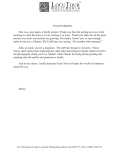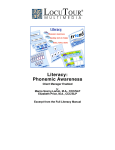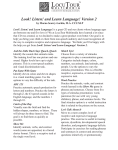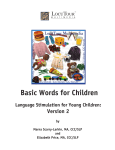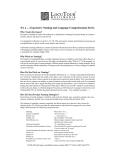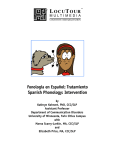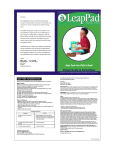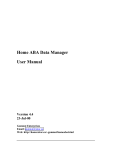Download Articulation III: Vowels + R and R Clusters
Transcript
™ LOCUTOUR M U L T I M E D I A C O G N I T I V E R E H A B I L I TAT I O N Articulation III: Vowels + R and R Clusters Objective The client will see a picture, hear it labelled, record their imitation of the word, sounds, phrase, or sentence, and determine accuracy of the production. Monitoring and Self-Monitoring: The client or clinician can determine if the target sound has been produced Correctly (C), Incorrectly (I), or Distorted (D). Use the “Record and Play” features to record and listen to the client's production of the target. Alternate between the model and the client's recorded words. Stress the importance of the concept that, “Contrast aids perception.” Listen for the samenesses and differences between the two productions. Have the client monitor their own speech and determine accuracy using the CDI button. Compare the client's perception of accuracy with your own. You may use the CDI button each time the client says the target word to keep a running tally of accuracy. Transfer activities can include writing on the homework sheets and recording new phrases and sentences for the target word. These recordings cannot be saved but can be repeated at the time of recording. Generalization can be practiced through recording “spontaneous conversations” that have the target word used somewhere in the conversation. The record feature will allow several minutes of recording if there is room on your hard drive to save the file temporarily. How to Play The clinician will assist the client in choosing a target sound or target sound cluster. The client will listen to the word as it is pronounced and try to replicate the sound or sound cluster. The client may listen to the word again by clicking on the Word button. Use the VCR-like buttons to record their voice. They may click on the Sounds button to listen and imitate the word segmented into individual phonemes. When there is accuracy at the phoneme and single word level, the client can use the Phrase button to hear the word used in a phrase or abbreviated sentence. After listening carefully, the client will repeat the phrase. Then the client will click on the Sentence button to hear the word used in a sentence. The client will repeat the sentence and may say another sentence using the word. Phonological Processing The client may click on the Exaggerated button to hear the word pronounced with the target phoneme or cluster exaggerated. Focusing on the processing and imitation of phonemes as presented on the Sounds button can develop central auditory processing of speech sounds, a difficult task for those with Central Auditory Processing Disorder (CAPD). Extensive practice imitating, sequencing, and representing each sound with a colored block or felt will help to improve reading and spelling skills. Response Options Use the touchscreen or mouse to select the Word, Sounds, Phrase, Sentence, or Exaggerated button to hear the target word spoken. By typing the numbers 1, 2, 3, 4, or 5 you will hear the sound corresponding to the Word(1), Sounds(2), etc. When you are finished with a screen, click on the right arrow or use the right arrow key to move to the next screen. The left arrow allows you to repeat the previous screen. The up arrow key or the up arrow on the volume button increases the volume and the down arrow decreases the volume. If you turn the volume off, you can scroll faster through the pictures using the right or left arrow keys. H takes you to the Help screen. X allows a quick exit from the program. The Print button allows you to print the picture on a homework page. Refer to the I Like Keys insert for more keyboard shortcuts. Options Random/Sequential, Hide Words/ Display Words, Lock Finish Button, Always Finish Speech/Allow Interrupt, Lower Sound Quality, Play Sound and Go to Next Picture, Choose First Speech Stimulus. ©1994-98 John Scarry and Marna Scarry-Larkin For information on other LocuTour Multimedia products call (800) 777-3166 or (805) 544-0775. ™ LOCUTOUR M U L T I M E D I A C O G N I T I V E R E H A B I L I TAT I O N Random on: Words and pictures appear in random order within a group. Random off: Words and pictures are ordered within a group from easy to hard. Hide Words: Choose this option to hide the word, phrase, and sentence. Option H will toggle the hide word/display word while on the screen to allow auditory memory practice or decoding practice. Always Finish Speech: Choose to prevent the client from interrupting the computer’s speech model. Lower Sound Quality: Choose if you’re running out of space on the hard drive. Play Each Sound then go to the Next Picture: Computer will play all five models, then go to the next picture automatically. Options Page 2: The password to get to Page 2 is options. Choose Picture Sets: Choose groups of words and save the choices for future use. Lock Finish Button: Choose to prevent the client from ending program before the clinician is ready. First Speech Stimulus: Clinician can choose what the client will hear when the picture comes up. This includes having the client hear nothing unless a button is clicked. Categories The main screen has four predefined categories to choose from: L clusters , R Clusters, S clusters, and Other (clusters with other letters). There are also eight buttons that the clinician can use to define and save categories for later use. Select groups of words for these buttons from Options page 2. (The password to get to Page 2 is options.) You may also choose groups of words by clicking on the Choose Words button. Clicking on this button takes you to the first of six screens for choosing word groups. Click on the button for the word group or groups that you wish to practice in this session. Use the arrow keys to move to the next or previous screen. You can deselect a group by clicking on it to turn off its highlight. When you have finished your selection, click on the Play Game button at the bottom of the screen. All of the words in the groups that you have highlighted will be displayed when the game is played. They will play approximately from left to right, starting on page 1 and moving to page 6. Screens There are a total of 572 photographs. The 76 groups are of uneven sizes. Some categories are used more frequently in English so there are more words for practice. Game Results By Trial: Category, % Correct, % Distorted, % Incorrect, and Average Time. Rationale This task requires the ability to attend to a series of complex auditory stimuli, analyze the sound segments, and imitate these sounds in sequence. It requires auditory processing at the sound, syllable, phrase, and sentence levels with imitative or spontaneous expressive articulatory production. Word Selection The R CD has two major categories. They are r-controlled vowels and r clusters. Speech is practiced primarily with commonly used words that contain /r/. The less common words were chosen for consonant location and vocabulary development. We tried to order the words from easiest to hardest but as you know, word difficulty depends on the individual client. We chose the following easy to hard hierarchy: s, s blend, l, r, lr, rl. Sound segmentation is based on the LocuTour Guide to Letters, Sounds, and Symbols. Pronunciation We used the Webster's New Collegiate Dictionary as our reference for pronunciation, and, in general, we chose the most common pronunciation if there was more than one choice. There were exceptions to this general rule based on my knowledge of stimulating articulation. For example, “yel*low” is most effectively taught as a three syllable word, “ee, el, oe” but is pronounced, “yellow” once learned. The syllable breaks most often coincide with the dictionary syllabification rules. When they don’t, the breaks were chosen to facilitate sound production. For example, the words, “cylinder” and “calendar” are broken “cyl•in•der” and cal•en•dar” in the dictionary. We chose to break them as “cy•lin•der” and ca•len•dar to facilitate temporal processing. The client has more time for correct placement of the /l/ with our syllable breaks. (Understanding that though this is an /r/-concentrated CD, clients may still be struggling with other phonemes). The rule for exaggeration was to elongate the target sound or sounds for imitation during the initial stages of therapy. As for the way I talk, I was born in Pennsylvania, have lived in Ohio, Georgia, Maryland, Washington D.C., and five cities in California. I know my speech does not represent the entire country, but does approximate the “Midwestern American Dialect.” Color Highlights Usually in a doubled consonant, the first consonant was “grayed-out” and the second consonant was pronounced, e.g., “wal*let.” Once again, if this was not done, it was decided that the alternative was easier to produce. Grayed-out letters meant that the sound was silent as in, kn, wr, gn, ight, mb, ll, ff, gg, ck, etc. Some notice for spelling irregularities was made by highlighting the sounds that did “not play fair,” belonged together, or needed special notice. I dubbed these, "notice me letters" and used the color maroon to highlight them, e.g., ate, ph, tch, dge, ce, ge, ti, ci, si, eo, etc. If a vowel combination did “not play fair” as listed in the Guide, then these vowels were highlighted. ™ LOCUTOUR M U L T I M E D I A C O G N I T I V E R E H A B I L I TAT I O N Alternative Uses for the Articulation CD Program Central Auditory Processing Disorder Recent research indicates that phonemic processing is critical to auditory processing of connected speech. This CD allows for auditory processing of speech sounds at the phoneme level using the Sounds button. This slow segmentation of the word allows the listener to process the phonemic units that make up the word, imitate the units, record their production, and play back their speech to selfmonitor. Self-correction and self-monitoring are the first steps in automatic integrated auditory processing and accurate verbal expression. Literacy Development and Dyslexia This game is appropriate for children and adults learning to read or those with reading and spelling difficulty. The gray colored letters indicate the silent letters such as: kn, gh, mb, rh, mn, gn and ck. The “e” rule allows the letter “e” to jump over one sound, (b, t, th, ch, sh, m, etc.) or one letter, (never tt, or bb, etc.) to make the vowel say its name. Silent “e” is highlighted in the color maroon. For example, the vowel sound in “cape” says, “ae” but the spelling is, “cape”, not “caep.” We teach that the, “e” jumps over and bops the “a” on the head to make him say his name. This single rule, the “erule” can make a huge difference in a person's ability to sound out new words. Other rules that can be taught include the “c and g - rules.” Any spelling book has a description of these rules but in essence, “c” followed by i, e, or y says its sound /s/, otherwise, “c” says /k/. ( pencil, ice, bicycle, coat, cap, etc.). “g” followed by i, e, or y can say the sound /j/, (engine, package, gym), but doesn't have to. It can say its sound, /g/ , (give, get, etc). The /sh/ sound can be spelled many different ways, such as “ti” (carnation) or “ci” (musician). We used the maroon color to highlight what we call, “notice me” sounds. These are sounds that don't quite play fair and need to be noticed for spelling or pronunciation. Refer to the LocuTour Guide to Letters, Sounds, and Symbols for more information about spelling and pronunciation rules. Transfer activity: Use the homework pages to practice copying the word and spelling new sentences. If the client copies the word from the computer screen to a word list, they are also developing shifting attention skills, visual perceptual and motor sequencing skills. Vocabulary Development While this CD series is titled, “Articulation,” there is no reason why it could not be used for language therapy. Choose the button labelled, All, and from the options page choose Random to get words from each category. This is a fun way to build receptive and expressive language skills. We tried to incorporate pictures from around the world to help develop general fund of knowledge about people, places, and things. Auditory Memory and Working Memory Requiring forward and backward repetition of the words, phrases and sentences can help those with short term memory problems, sustained, and shifting attention difficulties. Use felt squares on the table to “anchor” the sounds in sequence. I have used this process of backward repetition to increase the amount of information a client can hold in working memory. The process of forward repetition can teach the compensatory strategy of “reauditorization.” If you can develop your “internal tape recorder” you have a chance to replay and thus comprehend auditory information. Aphasia Therapy The pictures in this CD can be used to stimulate conversational speech, check auditory comprehension, and practice repetition, naming, writing, and reading skills. Use the record features to make your own cueing strategies. The program is designed to present a speech model at the sound, word, phrase, and sentence levels. You can record your own, “It's a ...” phrases, sentence completion, or phonemic cue sentences for individualized cueing. The record feature will allow several minutes of recording but will not save the recording when you move to the next page. ™ LOCUTOUR M U L T I M E D I A C O G N I T I V E R E H A B I L I TAT I O N Right Hemisphere Syndrome The treatment of Right Hemisphere dysfunction includes visual scanning, reading, writing, speech intonation, perception of affect, comprehension of humor, idioms, metaphors, and logic. The pictures can be used as a launching point for describing the details of visual images such as, color, size, shape, number, smell, taste, sound, perspective, movement, mood, and background. The main idea of the picture can be identified to assist with focusing on relevant stimuli and ignoring irrelevant details. One extension activity that can be used is to have the individual tell what could happen next. The individual will need to understand the gestalt of the picture story before making their own extension sentences or inferring meaning from the picture. Questions such as, “What was the dog doing?” and, “Why do you think he might be feeling that way?” encourage them to tell brief stories. These can be taped using the recording feature and played back to allow some processing of their own speech. You could track topic maintenance, or appropriateness of responses. Traumatic Brain Injury The communication deficits related to TBI often include dysarthria, auditory and reading comprehension problems, anomia, and pragmatic language disorders. In a small group setting, the CD can be used to present a stimulus and allow the individuals to practice turn taking, appropriate conversation, and topic maintenance. It is possible to use the recording features for feedback and self-monitoring on perseverative responses, inappropriate laughter, swearing, and off task responses. Use of the Sequential presentation option allows the clinician to present the same stimuli each day. As the client progresses, the variability for responses can be increased by using the Random option. Repeating the words, phrases, and sentences forward and backward on a level at which your client is 85% successful will develop working memory, short-term memory skills, and mental flexibility. I always use felt squares to “anchor” the words. Dysarthria and Apraxia Auditory feedback is critical for self-monitoring of dysarthric speech. The pictures were chosen for content, phonemic complexity, and “picturability.” The screen was designed to allow printed and/or auditory stimuli. An Apraxic client may prefer to have the words displayed and use the Word and Phrase buttons for self-paced imitative speech practice. The Dysarthric client may choose to practice sounds in words, phrases, and sentences for improved intelligibility. Most clients can practice on their own or with an assistant. Use of the CDI button will allow the client to keep track of their perception of the accuracy of reproduction of the stimulus. The comparison of their perception of intelligibility and your perception of intelligibility can be insightful when planning therapy goals. ™ LOCUTOUR M U L T I M E D I A C O G N I T I V E R E H A B I L I TAT I O N I Like Keys: Articulation Main Screens à (right arrow) go to the next word ß (left arrow) go to the previous word á (up arrow) increase the sound volume â (down arrow) decrease the sound volume “Option” and “R” toggle between random and sequential “Option” and “H” toggle between displaying/hiding the text “Option” and “N” go to the Enter Names Screen “Option” and “P” print the picture and homework “F” return to the main screen “?” go to the Help Screen “H” go to the Help Screen “E” exit, quit the program “R” record the word “S” stop recording the word “P” play back the word “C” score the pronunciation as correct “D” score the pronunciation as distorted “E” or “I” score the pronunciation as incorrect (error) “1” play the sound for the word “2” play the sound for the sounds “3” play the sound for the phrase “4” play the sound for the sentence “5” play the sound for the exaggerated target sound in word Note: If the shortcut says “Option” and “key” then the “Option” key is acting like the shift key. Press the “Option” key and while holding it down, press the other key in the command. (Windows users should press the Control Key.) ™ LOCUTOUR M U L T I M E D I A C O G N I T I V E R E H A B I L I TAT I O N Menu Screen “O” go to the “Options” screen “F” Finish the program “?” go to the Help Screen “H” go to the Help Screen RETURN start or continue the practice session without resetting the counter or the random number generator and to replay the words in the that were selected using the Choose Words button SPACEBAR start the practice session and reset counters and the random number generator Results Screen “F” quit the program “M” return to the Main Screen “?” go to the Help Screen “H” go to the Help Screen “P” page setup “Option” and “P” print the results page Options Screen “Option” and “R” toggle between random and sequential “Option” and “H” toggle between displaying the word and hiding it “Option” and “N” go to the Enter Names Screen “Option” and “H” go to the Help Screen “D” or RETURN return to main menu Help Screen “D” or RETURN return to main menu Names Screen TAB toggle between names fields RETURN record the names and return to main menu ABC 123 Game The keys for And a One, Two, Three will work with ABC 123. ™ LOCUTOUR M U L T I M E D I A C O G N I T I V E R E H A B I L I TAT I O N ABC 123 What’s My Name, What’s My Number What’s My Sound, What’s My IPA Symbol. Objective The client will repeat letter names, numbers, letter sounds, and IPA Symbol sounds after the voice stimulus. How to Play The client listens to the voice and watches the screen, then repeats the name of the letter, the name of the number, the sound of the letter, or the sound of the IPA symbol. Click on the Next button to move to the next screen. Response Options Clicking on the right arrow or pressing on the right arrow key moves you to the next screen without recording a correct or incorrect response. The left arrow allows you to repeat the previous screen. The up arrow key, or the up arrow on the volume button, increases the volume and the down arrow decreases the volume. If you turn the volume off, you can scroll faster through the pictures using the right or left arrow keys. H takes you to the Help screen. X allows a quick exit from the program. The Print button allows you to print the picture on a homework page. Refer to the I Like Keys insert for more keyboard shortcuts. Recording Options Use the mouse to click on the VCR-like controls beneath the Listen to the Sound button. The round red button records your voice. The red rectangular button stops the recording (or the playback) and the green triangular button plays the sound. If the buttons are gray they are not available. Options Game Results Rationale Random By Trial: Category, % Correct, % Distorted, % Incorrect, and Average Time. This task is intended for clients in Rancho Level VII and above and requires the ability to attend to an auditory stimulus. This task is designed to prepare the client for letter, number and word recognition tasks found on other LocuTour games. This game establishes the “rules” for consonant and vowel sounds utilized in the other games. Alternative This game is appropriate for children and adults learning language, pre-reading and math skills, or those with reading and spelling difficulty. This game can also help develop pronunciation skills with those individuals learning English as a second language.







